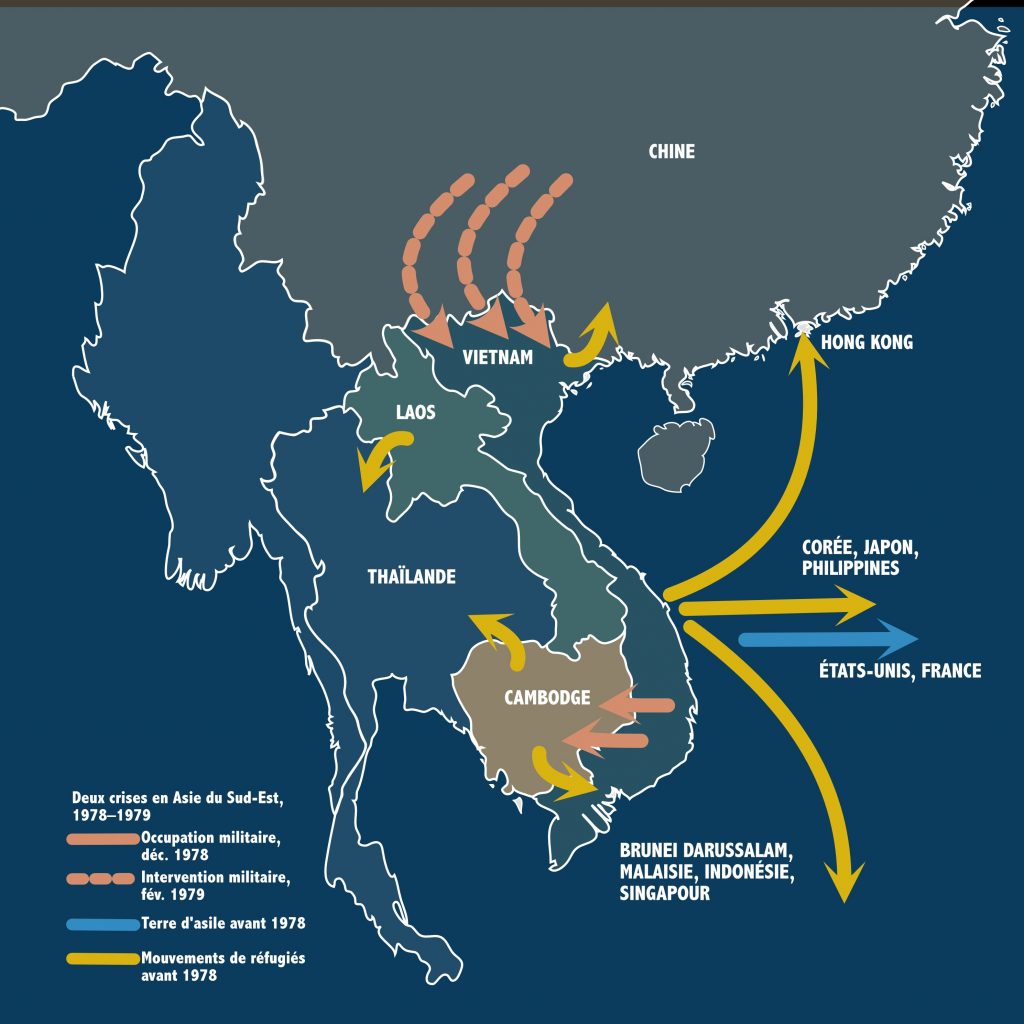References
- Que, Le Thi, Terry A. Rambo, et Gary D. Murfin. “Why They Fled: Refugee Movement During the Spring 1975 Communist Offensive in South Vietnam.” Asian Survey 16, no. 9 (1976): 855–63.
- Rambo, Terry A., J.M. Tinker, et J.D. LeNoir. The Refugee Situation in Phu Yen Province. McLean: Human Science Research Incorporated, 1967.
- L’exemple le plus célèbre fut lorsque Saigon et la marine des États-Unis lancèrent “Operation Passage To Freedom” en 1954 afin, d’amener les personnes à rejoindre le sud du Vietnam après la division temporaire du pays. Voir la bibliographie pour des références à cet évènement.
- Rand Corporation. RAND séries d’entrevues du Vietnam TET-B: Réactions des réfugiés à l’offensive du têt. 1972, Corporation Rand . RAND séries d'entrevues du Vietnam AGR: Attitudes des réfugiés par rapport à plusieurs aspects du conflit. 1972.
- L’exemple le plus célèbre de cela est probablement Huntington, Samuel P. “The Bases of Accommodation.” Foreign Affairs 46 (1968): 642–56.
- Voir Espiritu, Yen Le. Body Counts: The Vietnam War and Militarized Refugees. Berkeley: University of California Press, 2014 pour voir une étude récente qui poursuit une approche critique à l’arrivée des Vietnamiens aux États-Unis. Une autre étude récente : Nguyen, Nathalie Huynh Chau. Memory is Another Country. Greenwood, 2009, and Nguyen, Nathalie Huynh Chau. New Perceptions of the Vietnam War. McFarland, 2015. Un projet récent a mené des entretiens avec des réfugiés et les acteurs gouvernementaux canadiens de l'époque, www.https://heartsoffreedom.org/ Pour une approche plus classique mais néanmoins comparative, voir Hein, J. (1993), States and International Migrants, the Incorporation of Indochinese Refugees in the United States and France, Boulder: Westview Press. Pour les États-Unis uniquement, voir Hein, J. (1995), From Vietnam, Laos, and Cambodia: A Refugee Experience in the United States, New York: Twayne Press. Pour la France, Meslin, Karine. Les Réfugiés du Mékong, Cambodgiens, Laotiens et Vietnamiens en France. Détours: Bourdeaux, 2020.
- Woodside, Alexander. “Nationalism and Poverty in the Breakdown of Sino-Vietnamese Relations.” Pacific Affairs 52, no. 3 (1979): 381–409 propose une bonne discussion sur l’impact de ces réformes sur les personnes d’origine chinoise au Vietnam. Pour une chronologie détaillée de ces réformes, voir Quinn-Judge, Sophie. “Chronology of the Hoa Refugee Crisis in Vietnam,” In The Third Indochina War, Conflict Between China, Vietnam and Cambodia, 1972–1979, dirigé par Odd Arne Westad, and Sophie Quinn-Judge, London: Routlege, 2006, 234–37. Une explication des aspects légaux peut être trouvée dans Chiu, H. (1980). Current Developments: China’s Legal Position on Protecting Chinese Residents in Vietnam. American Journal of International Law, 74(3), 685-693. Toujours sur les réfugiés d'origine chinoise, Benoît, C. (1981), ‘Vietnam’s “Boat People”’, in D. W. P. Elliott (ed), The Third Indochina Conflict, Boulder: Westview Press, 139–62, Willmott, W. E. (1980), ‘The Chinese in Indochina’, in E. L. Tepper (ed), Southeast Asian Exodus: From Tradition to Resettlement, Ottawa: Canadian Asian Studies Association, 69–80. Sur les réformes communistes, voir Path, K. (2020), Vietnam’s Strategic Thinking During the Third Indochina War, Madison: University of Wisconsin Press, Ngô Vinh Long. “The Socialization of South Vietnam,” In The Third Indochina War, Conflict Between China, Vietnam, and Cambodia, 1972–1979, dans le même volume, pp. 33–64 or Duiker, William J. Vietnam Since the Fall of Saigon. Athens: Ohio University Center for International Studies, 1980.
- Les références les plus importantes au sujet des Khmers rouges sont : Kiernan, Ben. The Pol Pot Regime: Race, Power, and Genocide under the Khmer Rouge, 1975–1979. New Haven: Yale University Press, 1996, Kiernan, Ben. How Pol Pot Came to Power: Colonialism, Nationalism, and Communism in Cambodia, 1930–1975. New Haven: Yale University Press, 1985, Chandler, David. The Tragedy of Cambodian History, Politics, War, and Revolution since 1945. New Haven: Yale University Press, 1991, and Chandler, David. Brother Number One, A Political Biography of Pol Pot. Boulder: Westview Press, 1999.
- UNHCR 11/2/39/391 Volume 4, "Note by the High Commissioner, 29 November 1978," paragraphe 13.
- Pour le respect des états de l’Asie du Sud-Est des standards internationaux de la protection des réfugiés, voir Davies, Sarah. “Saving Refugees or Saving Borders? Southeast Asian States and the Indochinese Refugee Crisis.” Global Change, Peace & Security 18, no. 1 (2006): 3–24.
- Sur la rupture sino-soviétique et ses conséquences pour la guerre du Vietnam, voir Lüthi, Lorenz. The Sino-Soviet Split: Cold War in the Communist World. Princeton: Princeton University Press, 2008; Radchenko, Sergey. Two Suns in The Heavens, The Sino-Soviet Struggle for Supremacy, 1962–1967. Palo Alto: Stanford University Press, 2009; Gaiduk, Ilya. The Soviet Union and the Vietnam War. Chicago: Ivan R. Dee, 1996; Szalontai, Balazs. “Solidarity within limits: Interkit and the evolution of the Soviet Bloc’s Indochina policy, 1967–1985.” Cold War History 17, no. 4 (2017): 385–403; Ang Chen Guan. The Vietnam War from the Other Side: The Vietnamese Communists’ Perspective. London: Routlege, 2002; Ang Chen Guan. Vietnamese Communists’ Relations with China and the Second Indochina Conflict, 1956-1962. Jefferson: McFarland, 1997; Chen Jian. “China’s Involvement in the Vietnam War, 1964-69.” The China Quarterly 142 (1995): 356–87.
- Je m’appuie sur le volume dirigé sur la Troisième guerre d’Indochine pour l’information qui suit, Westad, Odd Arne, et Sophie Quinn-Judge, eds. Third Indochina War: Conflict Between China, Vietnam and Cambodia, 1972-1979. London: Frank Cass, 2006. Voir aussi l’étude innovatrice, Elliott, David W. P., ed. The Third Indochina Conflict. Boulder: Westview Press, 1981 et l’analyse pionnière de Chanda, Nayan. Brother Enemy: The War After the War. New York: Harcourt Publishing, 1986.
- Path, K. (2020), Vietnam’s Strategic Thinking During the Third Indochina War, Madison: University of Wisconsin Press.

